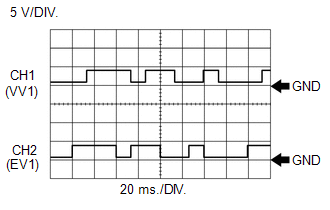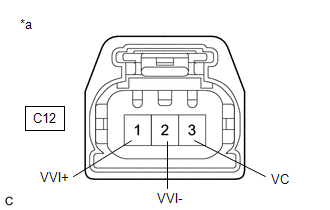DESCRIPTION The camshaft position sensor (for intake camshaft) (VV1 signal) consists of a magnet and MRE (Magneto Resistance Element).
The
intake camshaft has a timing rotor for the camshaft position sensor.
When the intake camshaft rotates, changes occur in the air gaps between
the timing rotor and MRE, which affects the magnetic field. As a result,
the resistance of the MRE material fluctuates. The camshaft position
sensor converts the camshaft rotation data to pulse signals, uses the
pulse signals. The ECM uses the pulse signals to determine the camshaft
angle. Then the ECM uses this data to control fuel injection duration
and injection timing. |
DTC No. | Detection Item |
DTC Detection Condition | Trouble Area |
MIL | Memory |
Note | | P034011 |
Camshaft Position Sensor "A" Bank 1 or Single Sensor Circuit Short to Ground |
The
camshaft position sensor (for intake camshaft) output voltage is less
than 0.3 V for 4 seconds or more (1 trip detection logic). |
- Open or short in camshaft position sensor (for intake camshaft) circuit
- Camshaft position sensor (for intake camshaft)
- ECM
| Comes on |
DTC stored | SAE Code: P0342 | |
P034015 | Camshaft Position Sensor "A" Bank 1 or Single Sensor Circuit Short to Battery or Open |
The
camshaft position sensor (for intake camshaft) output voltage is higher
than 4.7 V for 4 seconds or more (1 trip detection logic). |
- Open or short in camshaft position sensor (for intake camshaft) circuit
- Camshaft position sensor (for intake camshaft)
- ECM
| Comes on |
DTC stored | SAE Code: P0343 |
- Reference: Inspection using an oscilloscope.

HINT:
- The correct waveform is as shown.
- VV1 stands for the camshaft position sensor signal (for intake
camshaft), and EV1 stands for the camshaft position sensor signal (for
exhaust camshaft).
|
ECM Terminal Name |
CH1: Between VV1+ and VV1-
CH2: Between EV1+ and EV1- |
|
Tester Range |
5 V/DIV., 20 ms./DIV. |
|
Condition |
Idling with warm engine |
MONITOR DESCRIPTION If
the output voltage transmitted by the camshaft position sensor (for
intake camshaft) remains low or high, the ECM interprets this as a
malfunction in the sensor circuit, illuminates the MIL and stores a DTC. MONITOR STRATEGY |
Related DTCs | P0342: Camshaft position sensor range check (low voltage)
P0343: Camshaft position sensor range check (high voltage) | |
Required Sensors/Components (Main) | Camshaft position sensor (for intake camshaft) | |
Required Sensors/Components (Related) |
Crankshaft position sensor | |
Frequency of Operation | Continuous | |
Duration | 4 seconds | |
MIL Operation | Immediate | |
Sequence of Operation | None | TYPICAL ENABLING CONDITIONS |
All of the following conditions are met |
- | | Power switch |
On (IG) | | Time after power switch off to on (IG) |
2 seconds or more | |
Auxiliary battery voltage |
8 V or higher | |
Camshaft position sensor pulse input fail (P0340) |
Not detected | TYPICAL MALFUNCTION THRESHOLDS P0342: Range Check (Low Voltage) |
Camshaft position sensor voltage | Less than 0.3 V | P0343: Range Check (High Voltage) |
Camshaft position sensor voltage | Higher than 4.7 V | CONFIRMATION DRIVING PATTERN
HINT:
- After repair has been completed, clear the DTC and then check that the
vehicle has returned to normal by performing the following All Readiness
check procedure.
Click here 
- When clearing the permanent DTCs, refer to the "CLEAR PERMANENT DTC" procedure.
Click here 
- Connect the Techstream to the DLC3.
- Turn the power switch on (IG).
- Turn the Techstream on.
- Clear the DTCs (even if no DTCs are stored, perform the clear DTC procedure).
- Turn the power switch off and wait for at least 30 seconds.
- Turn the power switch on (IG) [A].
- Turn the Techstream on.
- Wait for 5 seconds or more [B].
- Enter the following menus: Powertrain / Engine / Trouble Codes [C].
- Read the pending DTCs.
HINT:
- If a pending DTC is output, the system is malfunctioning.
- If a pending DTC is not output, perform the following procedure.
- Enter the following menus: Powertrain / Engine / Utility / All Readiness.
- Input the DTC: P034011 or P034015.
- Check the DTC judgment result.
|
Techstream Display |
Description |
|
NORMAL |
- DTC judgment completed
- System normal
|
|
ABNORMAL |
- DTC judgment completed
- System abnormal
|
|
INCOMPLETE |
- DTC judgment not completed
- Perform driving pattern after confirming DTC enabling conditions
|
HINT:
WIRING DIAGRAM
 CAUTION / NOTICE / HINT
NOTICE:
HINT: Read
Freeze Frame Data using the Techstream. The ECM records vehicle and
driving condition information as Freeze Frame Data the moment a DTC is
stored. When troubleshooting, Freeze Frame Data can help determine if
the vehicle was moving or stationary, if the engine was warmed up or
not, if the air fuel ratio was lean or rich, and other data from the
time the malfunction occurred. PROCEDURE
| 1. |
CHECK HARNESS AND CONNECTOR |

|
*a | Front view of wire harness connector
(to Camshaft Position Sensor (for Intake Camshaft)) |
HINT: Make sure that the connector is properly connected. If it is not, securely connect it and check for DTCs again.
(a) Disconnect the camshaft position sensor (for intake camshaft) connector.
(b) Turn the power switch on (IG). (c) Measure the voltage according to the value(s) in the table below.
Standard Voltage: |
Tester Connection | Condition |
Specified Condition | |
C12-3 (VC) - Body ground |
Power switch on (IG) |
4.5 to 5.5 V | |
C12-1 (VVI+) - Body ground |
Power switch on (IG) |
3.0 to 5.0 V | (d) Turn the power switch off and wait for at least 30 seconds.
(e) Measure the resistance according to the value(s) in the table below.
Standard Resistance: |
Tester Connection | Condition |
Specified Condition | |
C12-3 (VC) - C12-1 (VVI+) |
Power switch off | 1.425 to 1.575 kΩ | |
C12-2 (VVI-) - Body ground |
Always | Below 1 Ω |
| OK |
 | REPLACE CAMSHAFT POSITION SENSOR (FOR INTAKE CAMSHAFT) |
|
NG |
 | |
| 2. |
CHECK HARNESS AND CONNECTOR (CAMSHAFT POSITION SENSOR (FOR INTAKE CAMSHAFT) - ECM) |
(a) Disconnect the camshaft position sensor (for intake camshaft) connector.
(b) Disconnect the ECM connector. (c) Measure the resistance according to the value(s) in the table below.
Standard Resistance: |
Tester Connection | Condition |
Specified Condition | |
C12-1 (VVI+) - C55-90 (VV1+) |
Always | Below 1 Ω | |
C12-2 (VVI-) - C55-89 (VV1-) |
Always | Below 1 Ω | |
C12-3 (VC) - C55-88 (VCV1) |
Always | Below 1 Ω | |
C12-1 (VVI+) or C55-90 (VV1+) - Body ground and other terminals |
Always | 10 kΩ or higher | |
C12-2 (VVI-) or C55-89 (VV1-) - Body ground and other terminals |
Always | 10 kΩ or higher | |
C12-3 (VC) or C55-88 (VCV1) - Body ground and other terminals |
Always | 10 kΩ or higher |
| OK |
 | REPLACE ECM |
| NG |
 | REPAIR OR REPLACE HARNESS OR CONNECTOR | | 
